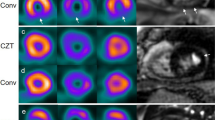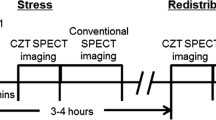Abstract
Objective
Since myocardial perfusion imaging (MPI) with conventional sodium iodine (NaI) device has low spatial resolution, there have been some cases in which small structures such as non-transmural myocardial infarction could not be properly detected. The purpose of this study was to evaluate potential usefulness of cadmium–telluride (CdTe) semiconductor detector-based high spatial resolution gamma cameras in detecting myocardial infarction sites, especially non-transmural infarction.
Methods
A total of 38 patients (mean age ± SD: 64 ± 21 year) who were clinically diagnosed with acute myocardial infarction were included. Twenty-eight cases of them were with ST segment elevation myocardial infarction (STEMI) and 10 cases with non-ST segment elevation myocardial infarction (NSTEMI). In all patients, myocardial perfusion single photon emission computed tomography images were acquired with Infinia (NaI device) and R1-M (CdTe device), and the images were compared concerning the detectability of acute myocardial infarction sites.
Results
The detection rates of the myocardial infarction site in cases with STEMI were 100 % both by NaI and CdTe images. In cases with NSTEMI, detection rate by NaI images was 50 %, while that of CdTe images was 100 % (p = 0.033). The summed rest score (SRS) value derived from CdTe images was significantly higher than that from NaI images in cases with STEMI [NaI images: 12 (7–18) versus CdTe images: 14 (9–20)] (p < 0.001). SRS derived from CdTe images was significantly higher than that derived from NaI images in cases with NSTEMI [NaI images: 2 (0–5) versus CdTe images: 6 (6–8)] (p = 0.006).
Conclusions
These results indicate that MPI using CdTe-semiconductor device will provide a much more accurate assessment of acute myocardial infarction in comparison to current methods.






Similar content being viewed by others
References
Tonino PA, De Bruyne B, Pijls NH, Siebert U, Ikeno F, van’t Veer M, et al. Fractional flow reserve versus angiography for guiding percutaneous coronary intervention. N Engl J Med. 2009;360:213–24.
Boiten HJ, van der Sijde JN, Ruitinga PR, Valkema R, Geleijnse ML, Sijbrands EJ, et al. Long-term prognostic value of exercise technetium-99 m tetrofosmin myocardial perfusion single-photon emission computed tomography. J Nucl Cardiol. 2012;19:907–13.
Hansen CL, Goldstein RA, Akinboboye OO, Berman DS, Botvinick EH, Churchwell KB, et al. Myocardial perfusion and function: single photon emission computed tomography. J Nucl Cardiol. 2007;14:e39–60.
Jaszczak RJ. The early years of single photon emission computed tomography (SPECT): an anthology of selected reminiscences. Phys Med Biol. 2006;51:R99–115.
Hachamovitch R, Hayes SW, Friedman JD, Cohen I, Berman DS. Comparison of the short-term survival benefit associated with revascularization compared with medical therapy in patients with no prior coronary artery disease undergoing stress myocardial perfusion single photon emission computed tomography. Circulation. 2003;107:2900–7.
Madsen MT. Recent advances in SPECT imaging. J Nucl Med. 2007;48:661–73.
Fukushima Y, Toba M, Ishihara K, Mizumura S, Seino T, Tanaka K, et al. Usefulness of 201TlCl/123I-BMIPP dual-myocardial SPECT for patients with non-ST segment elevation myocardial infarction. Ann Nucl Med. 2008;22:363–9.
Arruda-Olson AM, Roger VL, Jaffe AS, Hodge DO, Gibbons RJ, Miller TD. Troponin T levels and infarct size by SPECT myocardial perfusion imaging. JACC Cardiovasc Imaging. 2011;4:523–33.
Mori I, Takayama T, Motomura N. The CdTe detector module and its imaging performance. Ann Nucl Med. 2001;15:487–94.
Takahashi T, Mitani T, Kobayashi Y, Kouda M, Sato G, Watanabe S, et al. High-resolution Schottky CdTe diode detector. IEEE Trans Nucl Sci. 2002;49:1297–303.
Matsumoto C, Takahashi T, Takizawa K, Ohno R, Ozaki T, Mori K, et al. Performance of a new Schottkey CdTe detector for hard X-ray spectroscopy. IEEE Trans Nucl Sci. 1998;45:428–32.
Seino T, Kobashi K, Kiyanagi Y. A pulsed bias voltage shutdown circuit for a matrix readout system of a CdTe radiation detector. IEEE Trans Nucl Sci. 2010;57:726–31.
Seino T, Ishitsu T, Ueno Y, Kobashi K. Biparametric correction methods using two shapers for In/CdTe/Pt radiation detector. Nucl Instrum Methods A. 2011;629:170–4.
Chen H, Awadalla SA, Marthandam P, Iniewski K, Lu PH, Bindley G, et al. CZT device with improved sensitivity for medical imaging and homeland security applications. SPIE. 2009;7449:744902.
Chen H, Awadalla SA, Harris F, Pinghe Lu, Redden R, Bindley G, et al. Spectral response of THM grown CdZnTe crystals. IEEE Trans Nucl Sci. 2008;55:1567–72.
Guerin L, Verger L, Rebuffel V, Monnet O, et al. A new architecture for pixellated solid state gamma camera used in nuclear medicine. IEEE Trans Nucl Sci. 2008;55:1573–80.
Erlandsson K, Kacperski K, van Gramberg D, Hutton BF. Performance evaluation of D-SPECT: a novel SPECT system for nuclear cardiology. Phys Med Biol. 2009;54:2635–49.
Sharir T, Ben-Haim S, Merzon K, Prochorov V, Dickman D, Ben-Haim S, et al. High-speed myocardial perfusion imaging: initial clinical comparison with conventional dual detector anger camera imaging. JACC Cardiovasc Imaging. 2008;1:156–63.
Nakazato R, Berman DS, Gransar H, Hyun M, Miranda-Peats R, Kite FC, et al. Prognostic value of quantitative high-speed myocardial perfusion imaging. J Nucl Cardiol. 2012;19:1113–23.
Herzog BA, Buechel RR, Katz R, Brueckner M, Husmann L, Burger IA, et al. Nuclear myocardial perfusion imaging with a cadmium–zinc–telluride detector technique: optimized protocol for scan time reduction. J Nucl Med. 2010;51:46–51.
Tsuchiya K, Takahashi I, Kawaguchi T, Yokoi K, Morimoto Y, Ishitsu T, et al. Basic performance and stability of a CdTe solid-state detector panel. Ann Nucl Med. 2010;24:301–11.
Wackers FJ, Berman DS, Maddahi J, Watson DD, Beller GA, Strauss HW, et al. Technetium-99 m hexakis 2-methoxyisobutyl isonitrile: human biodistribution, dosimetry, safety, and preliminary comparison to thallium-201 for myocardial perfusion imaging. J Nucl Med. 1989;30:301–11.
Kubo A, Nakamura K, Sanmiya T, Shimizu S, Hashimoto S, Iwanaga S, et al. Phase I clinical study on 99mTc-MIBI. Kakuigaku. 1991;28:1133–42.
Cerqueira MD, Weissman NJ, Dilsizian V, Jacobs AK, Kaul S, Laskey WK, et al. Standardized myocardial segmentation and nomenclature for tomographic imaging of the heart: a statement for healthcare professionals from the Cardiac Imaging Committee of the Council on Clinical Cardiology of the American Heart Association. Int J Cardiovasc Imaging. 2002;18:539–42.
Reyes E, Stirrup J, Roughton M, D’Souza S, Underwood SR, Anagnostopoulos C. Attenuation of adenosine-induced myocardial perfusion heterogeneity by atenolol and other cardioselective beta-adrenoceptor blockers: a crossover myocardial perfusion imaging study. J Nucl Med. 2010;51:1036–43.
Hachamovitch R, Berman DS, Shaw LJ, Kiat H, Cohen I, Cabico JA, et al. Incremental prognostic value of myocardial perfusion single photon emission computed tomography for the prediction of cardiac death: differential stratification for risk of cardiac death and myocardial infarction. Circulation. 1998;97:535–43.
Sharir T, Germano G, Kang X, Lewin HC, Miranda R, Cohen I, et al. Prediction of myocardial infarction versus cardiac death by gated myocardial perfusion SPECT: risk stratification by the amount of stress-induced ischemia and the poststress ejection fraction. J Nucl Med. 2001;42:831–7.
Klocke FJ. Coronary blood flow in man. Prog Cardiovasc Dis. 1976;19:117–66.
Kurata A, Mochizuki T, Koyama Y, Haraikawa T, Suzuki J, Shigematsu Y, et al. Myocardial perfusion imaging using adenosine triphosphate stress multi-slice spiral computed tomography: alternative to stress myocardial perfusion scintigraphy. Circ J. 2005;69:550–7.
Nikolaou K, Knez A, Sagmeister S, Wintersperger BJ, Boekstegers P, Steinbeck G, et al. Assessment of myocardial infarctions using multidetector-row computed tomography. J Comput Assist Tomogr. 2004;28:286–92.
Al-Saadi N, Nagel E, Gross M, Bornstedt A, Schnackenburg B, Klein C, et al. Noninvasive detection of myocardial ischemia from perfusion reserve based on cardiovascular magnetic resonance. Circulation. 2000;101:1379–83.
Patel MR, Albert TS, Kandzari DE, Honeycutt EF, Shaw LK, Sketch MH Jr, et al. Acute myocardial infarction; safety of cardiac MR imaging after percutaneous revascularization with stents. Radiology. 2006;240:674–80.
Conflict of interest
All authors have no conflict of interests related to this paper.
Author information
Authors and Affiliations
Corresponding author
Rights and permissions
About this article
Cite this article
Fukushima, Y., Kumita, Si., Kawaguchi, T. et al. Nuclear myocardial perfusion imaging with a cadmium–telluride semiconductor detector gamma camera in patients with acute myocardial infarction. Ann Nucl Med 28, 646–655 (2014). https://doi.org/10.1007/s12149-014-0859-0
Received:
Accepted:
Published:
Issue Date:
DOI: https://doi.org/10.1007/s12149-014-0859-0




